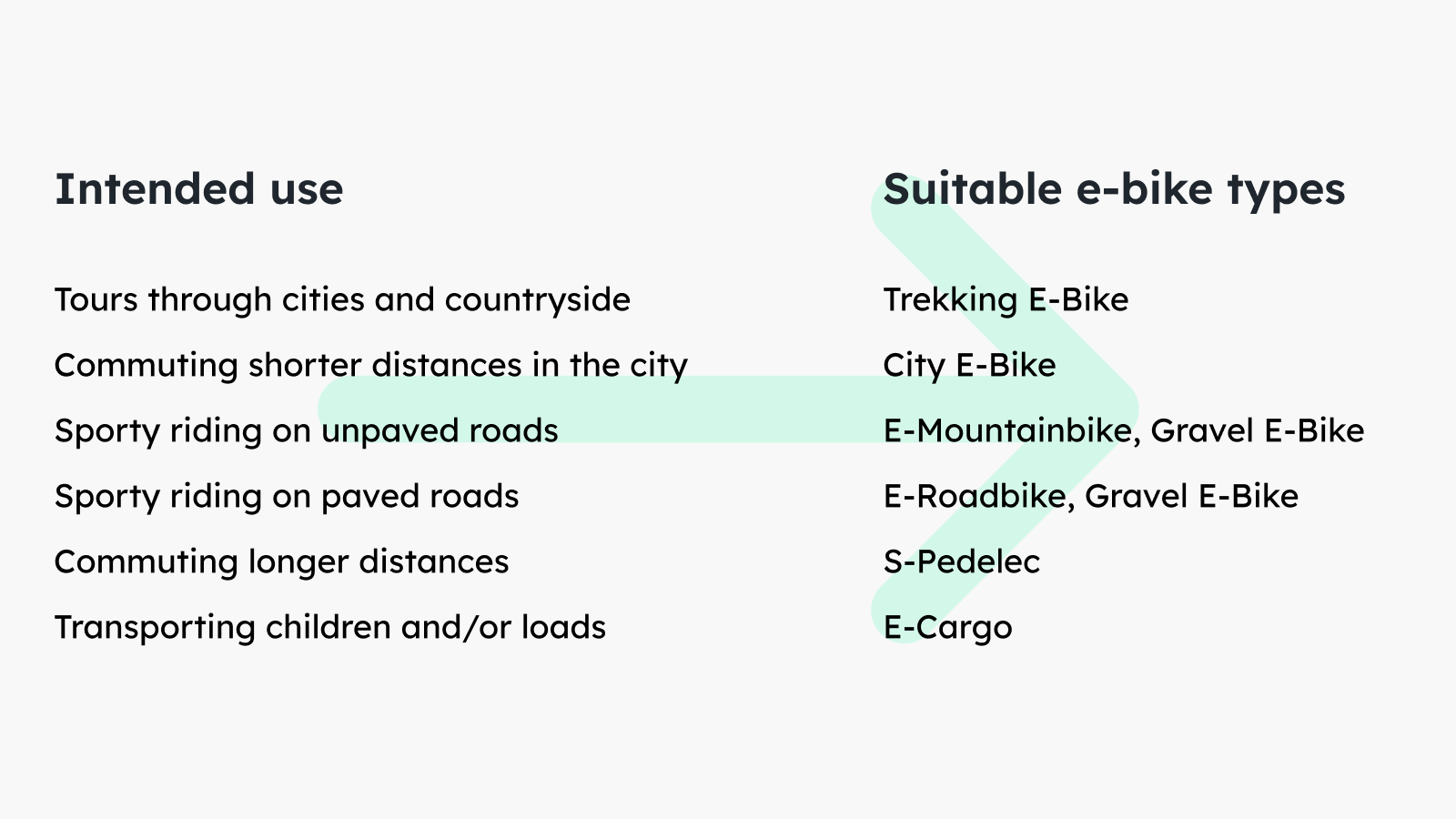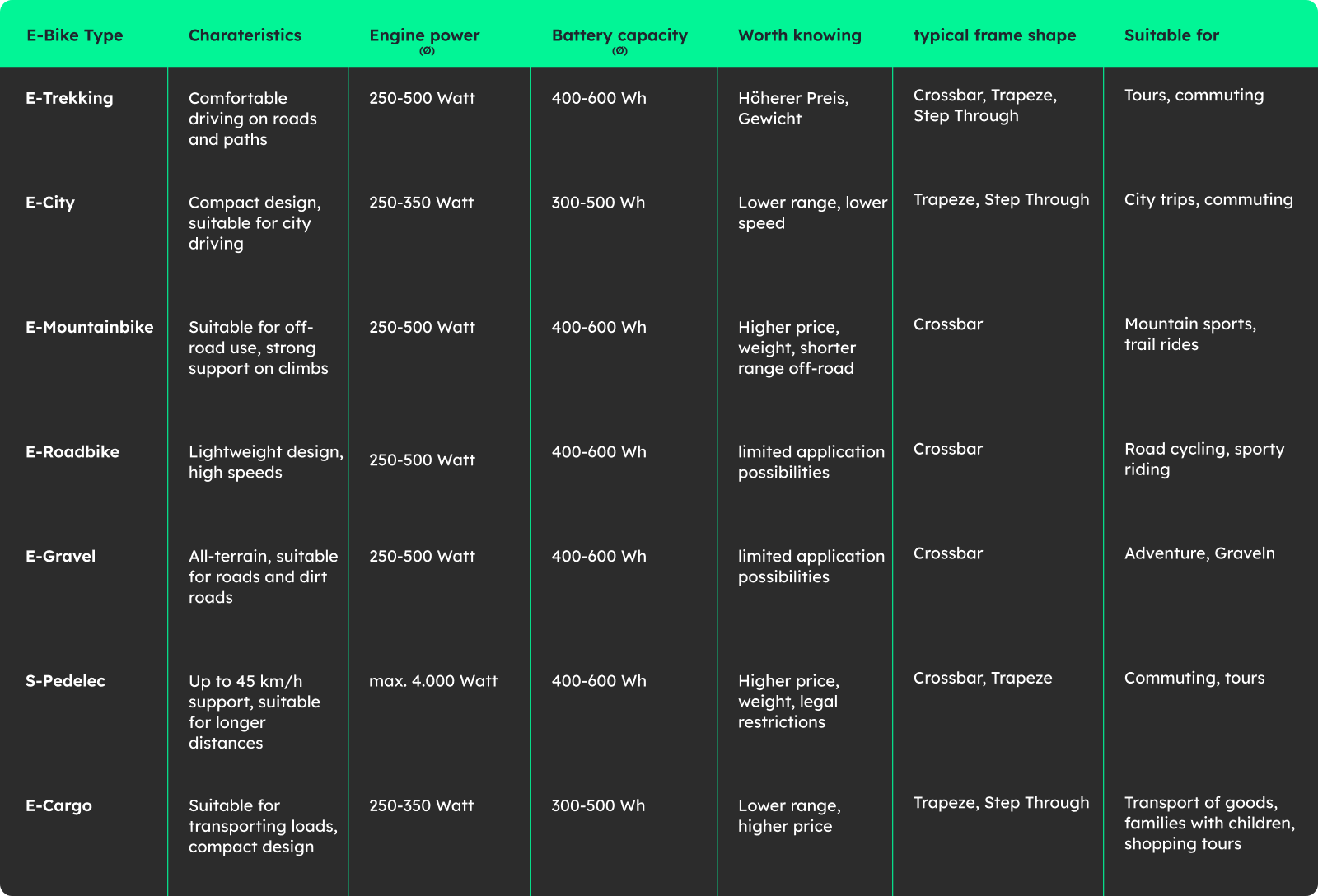Buying an e-bike: Which e-bike is the right one for me?

01 Feb.
·
Buying Guides

The popularity of motorized bicycles is increasing every year, and more and more people are switching to e-bikes. At the same time, e-bikes are not only a more comfortable and environmentally friendly alternative of transportation, but rather the bikes open up completely new possibilities for most. Whether for daily commuting, simply getting from A to B, or exploring the environments and nature around us.
`
With the addition of the electric motor, e-bikes help you ride through any headwinds with ease, climb mountains, and simply get around faster and farther. But buying an e-bike for many is an exciting and at the same time often quite complicated issue.
`
Meanwhile, the bike range includes a large number of e-bike types with a wide variety of features and specifications. It can be difficult to navigate among all the options and figure out which e-bike is best suited for your needs and preferences.
`
In addition, there are various technical elements to consider when buying an e-bike, such as battery, motor, wattage and range, which can be confusing for anyone unfamiliar with the technology. The price of e-bikes is also sometimes very confusing, which makes it difficult to focus on a budget and find the optimal offer.
`
To make your search for your dream bike as easy as possible, here you will find all the important information, questions and answers that are crucial when buying an e-bike.
`
The most important question: What do I want to do with an e-bike?
Riding an e-bike for the first time almost feels like gaining superpowers. The assistance of the electric motor when pedaling expands the possibilities on two wheels: The annoying stop-and-go traffic in the city becomes child's play, children or luggage can be transported without much effort, finally you reach your destination less sweaty and with the extra power, trips that would otherwise be too far or hilly are mastered.
`
E-bikes basically come in the same categories as conventional bikes: trekking, mountain and road bikes, but also more specialized models such as city, gravel, cargo or even compact bikes. Choosing the right type of e-bike can usually be narrowed down fairly quickly by answering the question of what the e-bike will be used for.
`
The question of where you want to ride is also crucial to making the right choice. Do you tend to ride on roads, bike paths, dirt roads and trails, or a little bit of everything? Just about every bike is suitable for asphalt, of course, so the choice becomes much more limited when it comes to finding an e-bike for dirt roads or gravel paths, for example. Here is a brief overview:

`
What types of e-bikes are there?
E-Trekking Bikes
Trekking e-bikes are the ultimate all-purpose option among e-bikes. These e-bikes have a robust and durable frame and have a sportier and longer riding position compared to city e-bikes. They are a mix of city and e-mountain bikes, making them perfect for traveling, touring and longer excursions.
`
They are also equipped with high-quality technical features, such as a powerful motor, a long-lasting battery, an efficient lighting system and an accurate display of the battery capacity.
`
With the motor assistance of an e-bike, you can cover longer distances than before. This assistance also allows you to increase your average speed, making rides more efficient. Hills and steep inclines that used to be a challenge can now be easily overcome with the e-bike's drive. In addition, you can carry more luggage on your rides thanks to the extra power.
`
With trekking e-bikes, what counts is durability and reliability. These e-bikes are designed for different surfaces such as paved roads, gravel paths and forest trails. To ensure that these bikes can withstand the stresses of these different terrains, they have two important features:
Sturdy hubs and wheels that provide robustness.
Aluminum frames that are lightweight yet strong and provide both comfort and safety
`
Comfort is another important aspect of trekking and touring e-bikes. These bikes are designed to make your tour as comfortable as possible.
`
E-City
City e-bikes are the perfect choice for daily commuting and running errands. Whether you're going to work, school, college, or just want to explore your city, these bikes will always give you a comfortable ride. The features of city e-bikes are predestined for use in the city, such as:
Removable battery for easy charging
Mudguards to keep you clean
Roadworthy lighting for added safety
A kickstand and luggage rack for added convenience
`
With an e-bike for the city, you choose a bike that is perfect for shorter distances and also requires very little maintenance.
`
E-Mountainbike
If you are a passionate mountain and hill lover who wants to conquer the toughest terrain without breaking a sweat, an e-mountain bike is the perfect choice for you. These bikes offer an exciting and sporty riding experience thanks to the assistance of the electric motor.
`
With their wide tires and reliable suspension, these bikes can handle any rocky path or trail. Even if you are not an experienced cyclist, you can conquer steep inclines with ease on an e-mountain bike.
`
E-mountain bikes come in two versions: fully suspended as a fully and as a hardtail. Fullys have suspension on both the front and rear wheel, while hardtail bikes only have suspension on the front wheel. E-mountain bikes are designed for use in difficult terrain with their special frame geometry, wide tires and robust components.
`
But these bikes are not only suitable for the mountains, but also for everyday use. The comfortable and sporty riding position and the additional safety features like disc brakes and suspension fork also make it an option for use through urban streets. The powerful drivetrain helps to start confidently in stop-and-go traffic while getting a sportier riding experience.
`
E-Roadbike
An e-road bike is the perfect companion for endurance cycling tours. The classic among two-wheelers is enriched by the additional power of an electric motor. The e-bike is suitable for both experienced and inexperienced riders and offers the perfect balance between support and muscle power.
`
Whether starting off, accelerating or tackling steep inclines - the e-bike drive always provides you with reliable support. The good thing about the limited motor support is that you don't have to forgo the desired training effects. So if you're looking for a sporty and efficient bike for your endurance training and long-distance tours, an e-road bike is the perfect choice.
`
Despite their additional weight (compared to conventional road bikes), e-road bikes have a slim design due to the drive system, which is similar to that of non-motorized road bikes thanks to the fully integrated drive system. Most e-road bikes have motors that cut out at 25 km/h to reduce resistance when pedaling at higher speeds. This is a practical feature for bikes that are typically ridden at high speeds.
`
The motors installed are usually center-mounted and transmit power directly to the rear wheel via the chain. For the powerful e-race bike models, a robust and powerful derailleur is essential to regulate the power transmission. With the high-quality disc brakes, you thus get an e-bike that brakes reliably in any weather and always allows a sporty driving experience.
`
E-Gravel
The E-Gravel Bike is the perfect choice for those looking for a road bike that is safe on unpaved terrain. With wider tires and disc brakes, this e-bike offers both safety and comfort, while a powerful motor gives the perfect support. The Gravel e-bike is also equipped with various options for attaching luggage, making it the ideal companion for your next bike tour as well.
`
Gravel bikes as an e-bike or even without motorization are considered one of the most popular bike types that have enjoyed great popularity in recent years. They are equipped for almost any situation and easily handle any cycling adventure on and off paved roads and trails. So if you're interested in an all-rounder that's designed for both sporty and leisurely riding, these e-bikes offer the best of both worlds.
`
S-Pedelec
With the new S-pedelecs, you are opting for e-bikes that are designed for speed. With a maximum power of 4,000 watts, these e-bikes can reach speeds of up to 45 km/h. This makes them perfect for commuting or longer rides. This makes them perfect for commuters or longer rides.
`
However, it is important to know that S-pedelecs are considered light motorcycles and require a Class AM driver's license, an insurance license plate and the wearing of a helmet. They cannot be ridden on bike paths and child seats and trailers are not allowed. However, the sturdier frame and stronger brakes ensure a safe ride at these high speeds.
`
If you're looking for an e-bike that can keep up with your fast-paced lifestyle, an S-pedelec is the perfect choice. And if you're an adventurer who likes to ride your e-bike through rough terrain, you'll love the S-pedelec's e-mountain bike option.
`
It's designed to handle heavy loads and high speeds, and it's equipped with high-quality gears for fast and smooth shifting. With an S-Pedelec, no matter which version, you'll experience speed and stability on two wheels like never before.
`
E-Cargo
Cargo e-bikes, also known as cargo e-bikes, are electric bikes with extra storage space. They are a great alternative to conventional cars for people who want to avoid the stress of finding a parking space in the city center and traffic jams. These e-bikes come in a variety of styles, from a two-wheeled cargo bike with a large cargo box between the rider and the front wheel, to a three-wheeled cargo bike with added stability and a cargo area in front of the rider.
`
One of the biggest advantages of cargo e-bikes is the ability to transport large items such as groceries, moving boxes and even children. They have a maximum payload of up to 200 kg and are powered by a motor that provides assistance. Cargo e-bikes are available in various designs and can be equipped with different accessories such as baby carriers or child seats.
`
They also offer the option of installing multiple batteries, making them ideal for longer trips. Overall, cargo e-bikes are a practical and environmentally friendly solution for transportation needs. They are therefore perfect for you if you often need to transport a lot of items or like to get from A to B with your kids in an uncomplicated way and take them along on all your trips.
`
What are the components of an e-bike?
E-bikes are currently one of the most popular types of bikes on the market. They combine the fun and benefits of cycling with the practical assistance of an electric motor. But what exactly distinguishes them from the conventional bicycle, what components does an e-bike have and what should you look for when choosing an e-bike?
`
The motor
One of the most important components of an e-bike is the electric motor. Depending on the model, the power of the motor can vary. It is important to choose the right motor for your needs. A more powerful motor usually means more support, but also a higher price and weight.
`
You have the choice between a motor that is built into the hubs (usually as a rear wheel drive), and a motor that is part of the bottom bracket (mid-motor). Both systems have their advantages and disadvantages. The advantages of rear wheel drives are that they have been on the market for a long time and are both cheaper, yet enormously reliable.
`
Mid-mounted motors, or *mid-drive* motors, are located in the bottom bracket area of the bike, which places the motor closer to the bike's center of gravity and makes the e-bike more stable. Because the motor is in close proximity to the chain drive, it can respond much more directly to your pedal torque, making mid-drive motors generally more efficient than rear-wheel motors. Mid-drive motors are therefore also particularly suitable for riding in the mountains or hilly regions.
`
How much assistance you get from the electric motor depends on the assistance level you set. The most powerful motors provide more than three times the energy input. For example, if you pedal with 100 watts, the motor supports you with another 300 watts, so that the e-bike is ultimately driven with an output of 400 watts. However, higher power levels are quickly noticeable in the battery's state of charge.
`
Do you prefer to ride with a lower support level? Then you save a lot of energy and the range increases significantly. But even if you run out of juice, that doesn't mean the end of your tour. If the motor fails due to a lack of battery power, you can continue riding your e-bike just as you would with a normal, albeit somewhat heavier, bicycle.
`
The battery
Another important component is the battery. The e-bike motor draws energy from the e-bike battery to power you wherever you go. It supplies the e-bike motor with power and significantly influences the range. That's why there are e-bike batteries for different requirements and with different installation and mounting options.
`
In the past, e-bike batteries were placed under the luggage rack or on the frame triangle, but today the trend is to hide the battery in the frame, in the down tube. There are fixed and removable versions of this type of battery accommodation, and nowadays almost every battery is installed in a removable version.
`
The rack battery is located under the rack and the frame battery on the frame triangle above the bottom bracket. There is also a partially integrated battery, which is located partly in the down tube and partly above.
`
It is important to pay attention to the capacity and range. A high-quality battery can offer a range of several hundred kilometers, while a weaker battery can only cover a few kilometers. You should also pay attention to the battery's charging time.
`
Most batteries today offer at least 500 watt-hours and allow for longer trips. If you have the opportunity to recharge along the way, you should do so. With the newer batteries, you can enjoy the new freedom that e-bikes offer without restrictions.
`
The display
Another important element of an e-bike is the display. Here you can not only read the speed, range and charge status of the battery, but also set the various support levels of the motor. It is important that the display is easy to use and easy to read.
`
The e-bike supplements your muscle power with motor power. You decide how much additional power you want it to provide by simply using your own strength and selecting the appropriate support level. Whether you want to break a sweat or arrive at the office without sweat stains, or simply want to cover a decent distance - you can set your e-bike for a wide range of needs with the simple push of a button.
`
Other components of an e-bike are basically identical in construction to organic bikes: brakes, gears, bike computer and lighting. Here, too, you should pay attention to quality, because these components are particularly important for safety and a smooth riding experience.
`
What are the frame shapes?
An important factor when selecting an e-bike is the frame shape, which not only determines the appearance of the bike, but also influences ride comfort and handling. The most common frame shapes for e-bikes are crossbar, trapeze and step-through. The classification is mainly based on how high a rider has to lift their leg and foot above the frame to get on the bike.
`
The high bar or tube in the center of the bicycle is called the top tube. On a crossbar frame, the top tube is relatively high, at about stride length. A trapeze or step-through frame, on the other hand, may have a very low top tube or no top tube at all, so you only have to lift your leg and foot a few inches off the ground to clear the frame.
`
Let's take a closer look at the most common types of frames.
`
Crossbar frame
If you're standing next to a crossbar frame that fits your size, you can assume that its top tube will reach at least to the middle of your thigh. This means that swinging your leg over the frame to get on the bike requires a certain amount of flexibility and agility. On modern e-bikes, with this frame shape, the top tube often gets lower towards the seat tube.
`
The crossbar frame is therefore often the first choice for sporty riding. The robust construction of the triangular frame efficiently focuses the pedaling force into speed. Crossbar frames are among the strongest shapes in technology and connect the frame in several places. This structure also results in better weight distribution: it puts the rider's center of gravity in a more natural position for better handling.
`
Crossbar frames summarized:
suitable for flexible, agile and sporty riders
extremely stable
have a relatively low weight
mainly found in e-mountain bikes, e-race bikes, e-gravel and e-trekking bikes
`
Trapeze frame
This frame is characterized by a medium-height frame with a steeply sloping top tube. While this means you have to lift your leg (significantly more than a low stepper), the angle requires much less effort than a diamond frame.
`
The trapeze frame is the optimal mix of ride comfort, sporty handling and stability. This is because the triangle between the top tube, down tube and seat tube provides the frame with very good stability. The slightly forward leaning seating position is thereby ideal for sporty use and the low top tube makes stopping, mounting and dismounting more comfortable than the crossbar frames.
`
Trapeze frames summarized:
stable frame, suitable for sporty as well as long rides
for the optimal mix of comfort and stability
mainly used for: Cross e-bikes, trekking e-bikes, city e-bikes
`
Step-through frame
The Step-through frame is designed for both women and men, so a wide range of riders will benefit from this type of bike. The top tube is usually not present at all on the deep-entry frame. This means that this frame type requires the least effort of all frame variants to get on the bike.
`
This frame type is therefore often referred to as the comfort variant. Step-through frames have gained popularity among e-bikes. The low entry also makes it easy to transport a child seat or basket on the rack. However, this design also has a few minor drawbacks. For example, compared to other frame designs, low riders are usually heavier and less torsionally stiff.
`
Step-through summarized:
very comfortable sitting position
suitable for frequent mounting and dismounting
the frame swings along, is more flexible
higher weight
mainly found in trekking e-bikes and city e-bikes
`
Which e-bike should I buy now? An overview
With the above information, you could certainly already gain valuable answers to your questions. Since the search for the right e-bike is a rather complex topic, you can use the following overview to have the most important points of the different bike types at a glance:

Note: This table refers to the most common versions of the respective e-bike types. In addition, there is a wide range of variants and versions that have been developed for special needs.
The most important questions that need to be answered before buying an e-bike
`
Conclusion
The feeling of cycling through the streets without much effort or completing wonderful tours through nature makes every ride a special experience. E-bikes help promote freedom and independence in terms of transportation for everyone. Switching to an e-bike as a means of transportation also reduces the burden on our environment.
`
A positive and important effect, which increases with every additional kilometer ridden. All these factors make buying an e-bike an exciting as well as fulfilling experience. We hope that we were able to give you a good overview and answer the most important questions when deciding on the right e-bike.
`
If you already know some factors about your desired e-bike, then you should start the search for the right model with our Bike Finder. This will help you to make a pre-selection of suitable e-bikes for you by answering a few questions. If you have any further questions, please do not hesitate to contact us. We are available for questions at any time by e-mail at customerservice@velio.de as well as via contact on our website (e.g. via WhatsApp).




